While Northern Italy is known for its rich, meaty stews, creamy risottos, and polenta, Southern Italy is known for its seafood, extra virgin olive oil, and the liberal use of tangy tomatoes in their cooking.
If North Italy has a lot of French, Austrian, and German influences, the South embraces a lighter, more Mediterranean cooking style. As some have put it, its flavors reflect the flavors of the coastline and the sea.
South Italy, specifically Naples, is also known as the birthplace of modern pizza. Aside from pizza, though, there is a whole host of other dishes that the South of Italy is known for.
In this article, we’ll journey through Italy’s south to explore some of its most famous dishes.

26 Most Popular Southern Italian Foods
- Neopolitan Pizza
- Mozzarella di Bufala
- Sfogliatella
- Spaghetti alla Puttanesca
- Spaghetti alla Chitara
- Arrosticini Abruzzesi (Lamb Skewers)
- Fusilli
- Orecchiette con cime di rapa
- Foccacia Barese
- Pane di Altamura PDO
- Pane di Matera
- Caciocavallo
- Burrata
- Canestrato Pugliese
- Soppressata di Calibria
- Su Porceddu (Sardinian Suckling Pig)
- Lagane e Cicciari
- La Sardella
- Cipolla Rossa di Tropea IGP
- ‘Nduja
- Arancini
- Caponata
- Pasta Alla Norma
- Cannoli
- Cassata Siciliana
- Limoncello

26 Most Popular Southern Italian Foods
1. Neopolitan Pizza
You can’t bring up the South of Italy and not talk about pizza. While the idea of pizza–a flatbread with various ingredients on top of it–has certainly been around for thousands of years, with Greek, Roman, and Egyptian origins, the modern idea of pizza was likely invented in Naples, a city in Campania in the southwest of Italy in the 19th century.
A popular account for the invention of Pizza Margherita goes that in 1889, a pizza maker named Raffaele Esposito created a simple pizza containing San Marzano tomatoes, basil, and mozzarella to celebrate the unification of Italy, with its colors representing the colors of the Italian flag: red, green and white.
It is said that he named it after Margherita of Savoy, then Queen Consort of Italy.
Pizza Margherita is just one type of Neopolitan pizza and is considered a basic pizza in Italy.
Neopolitan pizza is known for its soft, thin, chewy crust that is a little bit puffed up and has a little bit of charring, with the dominant use of tomato sauce and cheese. The crust should also be pliable and easy to fold.
- Characteristics: Soft, chewy crust known for its simplicity
- Featured Ingredient: San Marzano tomatoes, mozzarella
- Type of Dish: Main dish, snack
- Region of Origin: Naples, Campania
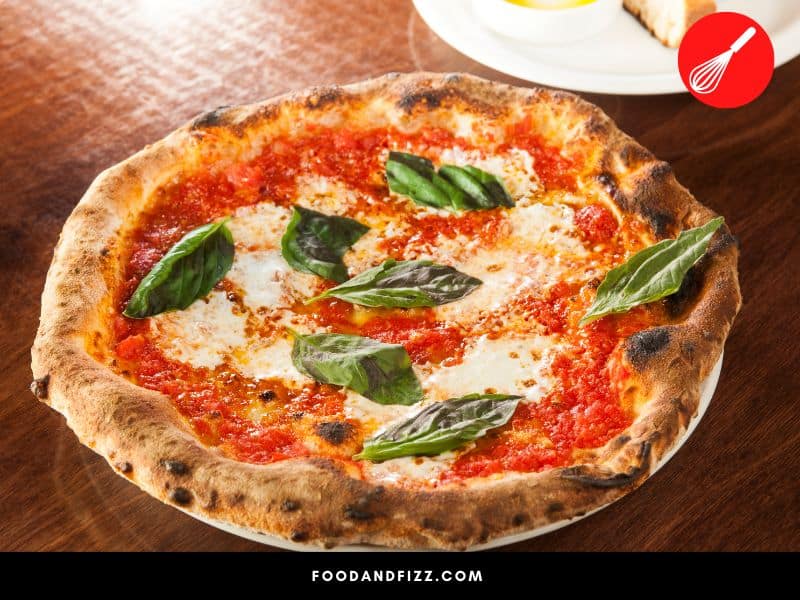
2. Mozzarella di Bufala Campana
While mozzarella is produced in many different regions, Campania’s Mozzarella di Bufala is one of the most prized.
Mozzarella di Bufala Campana is a soft white cheese made from the fresh whole milk of Italian Mediterranean buffalos and is a product with a PDO status or Protected Designation of Origin.
This means that only buffalo mozzarella produced in certified areas in Campania, Lazio, Puglia, and Molise can call their products this specific name, and they must follow strictly monitored guidelines and procedures for making it that are unique to this specific region.
Mozzarella comes from the word mozzare, which means “to cut off” in Italian. This refers to the process of stretching the curd into strips before cutting them into balls using the thumb and forefinger, which is how mozzarella gets its characteristic round shape.
Mozzarella di Bufala Campana has a mild, milky taste that is a little bit sour because of the lactic acid fermentation. It is usually packed in brine and acidified water. It is used in salads, and pizza, or enjoyed on its own with just a little drizzle of olive oil.
- Characteristics: Soft and smooth, porcelain white surface, creamy with a slightly sour taste
- Featured Ingredient: Buffalo whole milk
- Type of Dish: Antipasto, added to salad, pizza, or enjoyed on its own
- Region of Origin: Campania

3. Sfogliatella
Sfogliatella are shell-shaped pastries filled with sweet ricotta or custard. It is one of the most iconic Italian desserts and is a staple in bakeries in the Campania region of Italy, and is a common breakfast item.
In the U.S., it is also known as “lobster tail”. The name “sfogliatella” is actually a reference to its thin layers that look like leaves.
A popular story concerning its origins traces it back to the 1700s to a nun in the Santa Rosa monastery on the Amalfi Coast, who is said to have invented it by accident when she was trying to make some almond pudding.
As the nuns are not permitted to have outside contact, how the recipe managed to get out is a mystery, but it is said to have been obtained eventually by a pastry chef from Naples, who started selling it at his shop. It was there that it exploded in popularity.
There are two kinds of sfogliatella in Neopolitan cuisine: riccia (“curly”) and frolla (“smooth”).Sfogliatelle riccia is the more traditional and popular one, characterized by many layers of thin dough formed into a clam shape, filled with a custard-like filling made with ricotta, sugar, semolina, eggs, candied citrus peels, and cinnamon.
Sfogliatelle frolla is less labor intensive and is made with dough that is used for buttery pies and crusts, and rather than the thin delicate layers, it is more domed and round in shape.
The lobster tail we commonly see in the U.S. is similar to sfogliatelle riccia, except that it is larger and the filling typically used is sweeter than the Italian one, using something like whipped cream rather than custard.
- Characteristics: Custard or ricotta-filled pastries, characterized by layers of thin dough resembling stacks of leaves, popularly known in the U.S. as lobster tail
- Featured Ingredient: Thin layers of dough, custard-filling
- Type of Dish: Dessert, breakfast, or snack
- Region of Origin: Campania
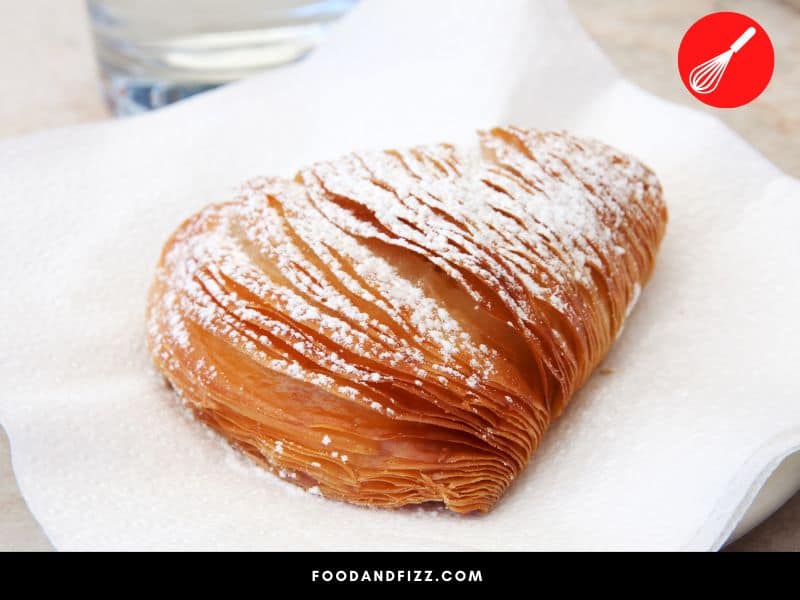
4. Spaghetti alla Puttanesca
Spaghetti alla Puttanesca is a tomato-based pasta sauce typically made with tomatoes, olives, anchovies, capers, garlic, chili, and olive oil.
Anchovies are typical of Puttanesca made in the Lazio region but are not always included in the Neopolitan sauce version. It is very young as far as pasta sauces go, and was said to have been invented and popularized in Naples during World War II.
The stories surrounding its name are very interesting. Some say it was named after Italian prostitutes (“puttana” in Italian), who could easily cook up this sauce in between clients. At the same time, food historian Jeremy Parzen claims that the term could also be used as general profanity, which means that it is possible that the name of the sauce came about from someone referring to the sauce as a bunch of *insert profane word here* that they just threw together in a pan.
No matter the origin, it is a fact that this pasta sauce is delicious, easy to put together, and represents the region it originated in quite well.
- Characteristics: Tomato-based sauce, savory, slightly sweet and acidic, spicy
- Featured Ingredient: Tomatoes, anchovies
- Type of Dish: Pasta
- Region of Origin: Naples, Campania
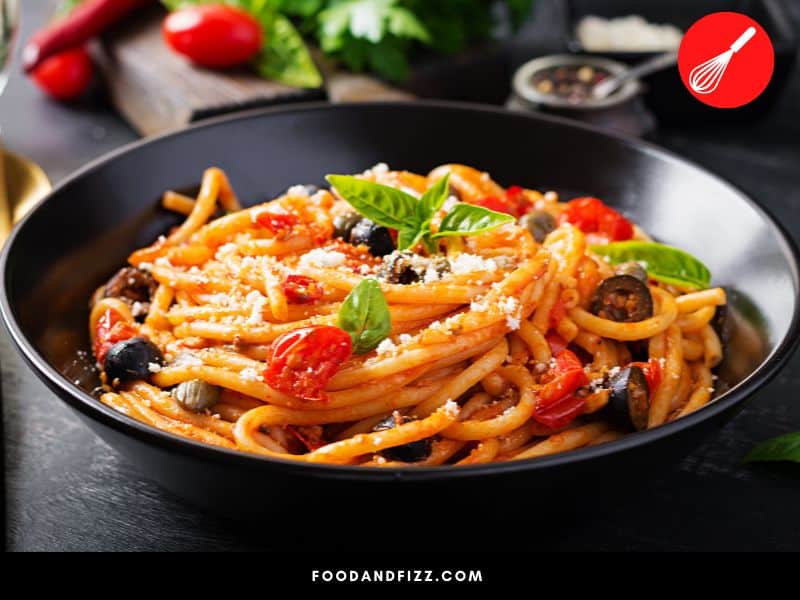
5. Spaghetti alla Chitarra
Also known as “maccheroni ala chitarra”, this egg pasta is very common in the Abruzzo region of Italy. The name literally means “guitar spaghetti”, because of the tool used to produce it.
A rectangular-shaped wooden frame called a chitarra, which has multiple thin wires running parallel to each other from top to bottom, is used to shape the pasta into thin threads.
The rolled-out sheet of pasta dough is placed on top of the chitarra and pressed with a rolling pin through the wires, resulting in strands of pasta that look like regular spaghetti, but with a more squarish shape. They are released from the frame by “playing” the strings like you would play a guitar.
Aside from its squarish shape, it differs from regular spaghetti in that it typically contains eggs and it is more porous than spaghetti. It is often served with things like Ragu All’ Abruzzese, a meat-based sauce typically made with lamb but can be made with other meats, and contains ingredients like tomatoes, onions, olive oil, bay leaves, and chili peppers.
- Characteristics: Squarish strands of egg pasta, made by hand with a chitarra
- Featured Ingredient: Made with a special tool called a chitarra
- Type of Dish: Pasta
- Region of Origin: Abruzzo
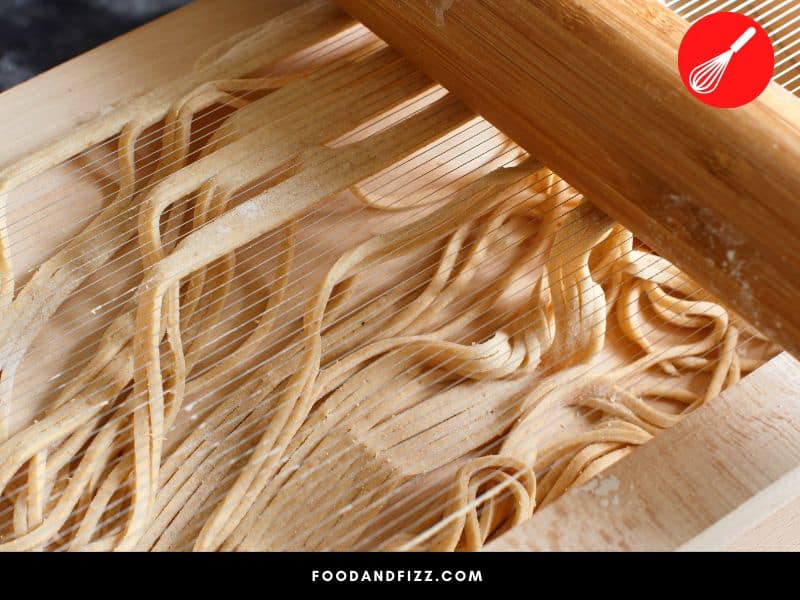
6. Arrosticini Abruzzesi (Lamb Skewers)
Arrosticini are cubes of lamb or mutton pierced by a skewer and grilled over an open flame.
Traditional arrosticini is made by hand, with varying sizes of meat chunks interspersed with some fat for flavor. It is traditionally eaten by pulling meat off of the skewer with your teeth.
This dish originated from the shepherds and inhabitants of the mountainous regions of Abruzzo, particularly those in the villages of Villa Celiera, Carpineto, Castilenti and Civitella Casanova.
Arrosticini is typically served with crusty bread, extra virgin olive oil, pane onde, and Montepulciano d’Abruzzo wine.
- Characteristics: Fatty lamb skewers grilled over an open flame
- Featured Ingredient: Lamb
- Type of Dish: Traditional meal of shepherds
- Region of Origin: Abruzzo
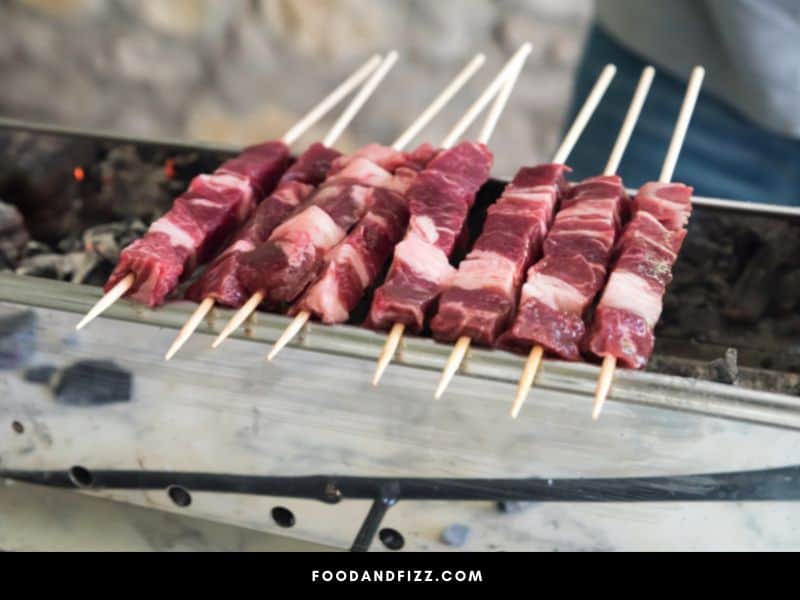
7. Fusilli
Molise is the second smallest region of Italy and the youngest one, only splitting away from the Abruzzo region in 1963. It is said to be one of the most unspoiled areas of Italy, and among the most beautiful.
Though it is not as well-known as its neighboring regions, there is one thing that it is very famous for – pasta. The abundance of durum wheat in the region and its surrounding areas make it an ideal area for making durum wheat pasta.
Perhaps the most well-known pasta to come out of Molise is fusilli, a spiral, corkscrew-shaped pasta that is versatile and useful for many applications. Its name came from how it was produced: by wrapping thin strips of pasta around a spindle called “fuso” in Italian, and then allowing it to dry that way.
Because of its grooves and its shape, fusilli is good for holding rich, creamy sauces as well as meat sauces and is also perfect for pasta salad and casseroles.
Fusilli Alla Molisana, fusilli pasta with lamb ragu, is a region’s specialty.
- Characteristics: Spiral, corkscrew-shaped pasta made with durum wheat
- Featured Ingredient: Durum wheat
- Type of Dish: Pasta
- Region of Origin: Molise
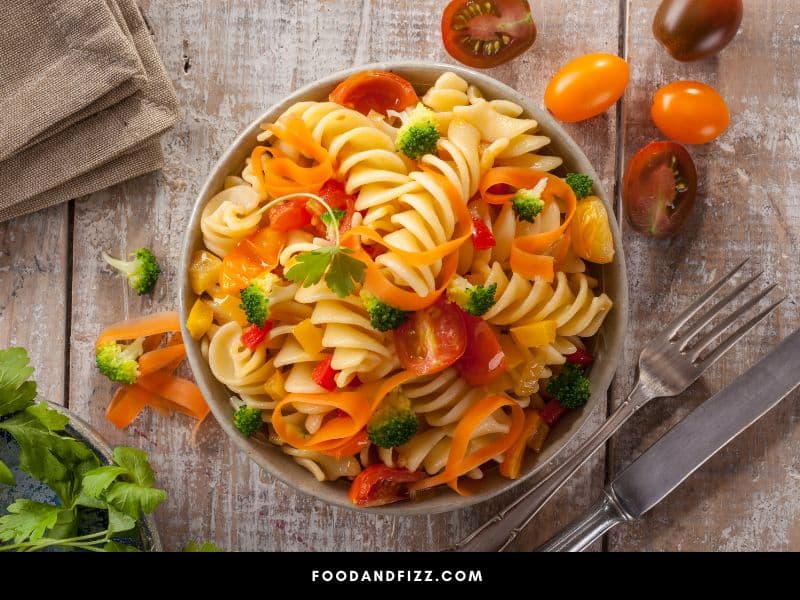
8. Orecchiette con Cime di Rapa
In this pasta dish, cime di rapa, also known as rapini or broccoli rabe, is boiled and cooked into a delicious sauce made with garlic, anchovies, extra virgin olive oil, and chili pepper, and then served with a small ear-shaped pasta called orecchiette.
Orecchiette is a typical Puglian pasta, made from semolina, water, and salt, rarely eggs. It is still common to see women in the region making orecchiette pasta in the middle of the street, with such mastery and precision as has been done for centuries.
- Characteristics: Small, ear-shaped pasta made from semolina and water, served with a garlicky sauce and broccoli rabe
- Featured Ingredient: Orecchiette
- Type of Dish: Pasta
- Region of Origin: Puglia
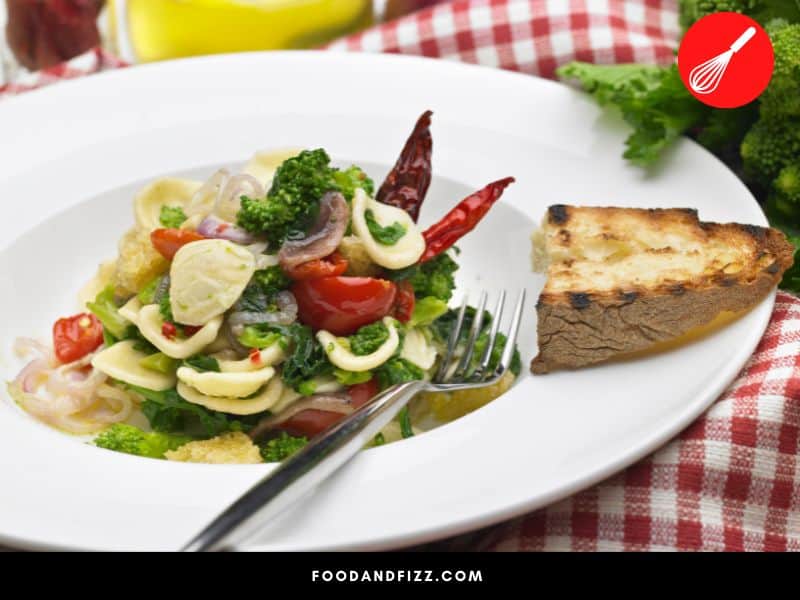
9. Foccacia Barese
Focaccia Barese (“From Bari”), is a Puglian variation of the classic Italian bread. The Puglian version is topped with tomatoes, black or green olives, olive oil, and oregano.
It sometimes has mashed potatoes in the bread dough to give it a lighter and fluffier texture. It is not too tall, has a nice crunch on the edges, but is soft in the middle.
Unlike its Ligurian cousin, Focaccia Barese is typically baked in a round pan, making it look even more like a thick pizza.
- Characteristics: Round in shape, has potatoes in the dough, tomatoes, olives and oregano
- Featured Ingredient: Mashed potatoes in the dough give it a lighter texture
- Type of Dish: Snack, Main Dish
- Region of Origin: Bari, Puglia

10. Pane di Altamura PDO
An ancient sourdough-type bread from the Puglia region which is documented to date back to the first century B.C. It is the only bread in the world with PDO-protected status, meaning the ingredients and recipe are highly regulated.
Pane di Altamura PDO is made with a specific, regional type of durum wheat semolina, and water, salt, and yeast that is specific to the designated production region. The production method also consistently produces a crust that is 3 mm thick, although the way it is shaped is not included in the regulation.
Pane di Altamura is the best bread in the world, with its mildly sour and sweet, subtly nutty flavor and moist, chewy texture that remains fresh for several weeks.
- Characteristics: Subtly sweet and sour, nutty and earthy, soft and moist texture
- Featured Ingredient: Durum wheat semolina
- Type of Dish: Bread
- Region of Origin: Puglia
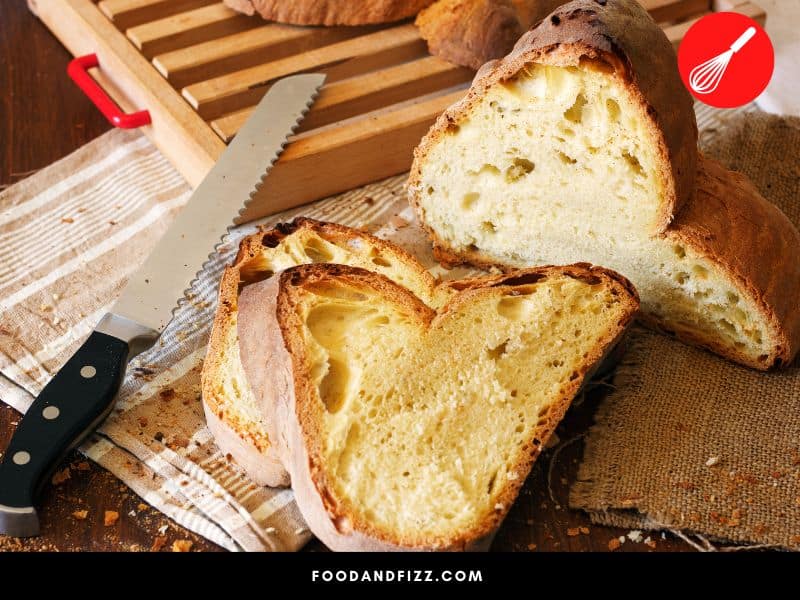
11. Pane di Matera
Matera is a city known for its cave dwellings and ancient settlements, which are UNESCO world heritage sites, and for its bread. Pane di Matera is an IGP-protected ancient bread made only in the city of Matera, made with a specific type of semolina grain grown here known as Senatore Cappelli.
It is a fermented bread like sourdough, slow-fermented with natural yeast taken from grapes and figs, resulting in strongly flavored bread that is slightly sour like sourdough. It is a crusty bread with a pale yellow crumb, with large holes, indicative of the long fermentation process.
Pane di Matera can be consumed with meats and cheeses, or on with olive oil and tomatoes. It stays fresh for a long time but once it does go stale, it can also be used in dishes like Pasta Mollicata, where it can be used as part of the actual sauce.
- Characteristics: Crusty exterior, pale yellow crumb with large holes. Slightly sour, strong flavor
- Featured Ingredient: Semolina, Senatore Cappelli
- Type of Dish: Bread
- Region of Origin: Basilicata
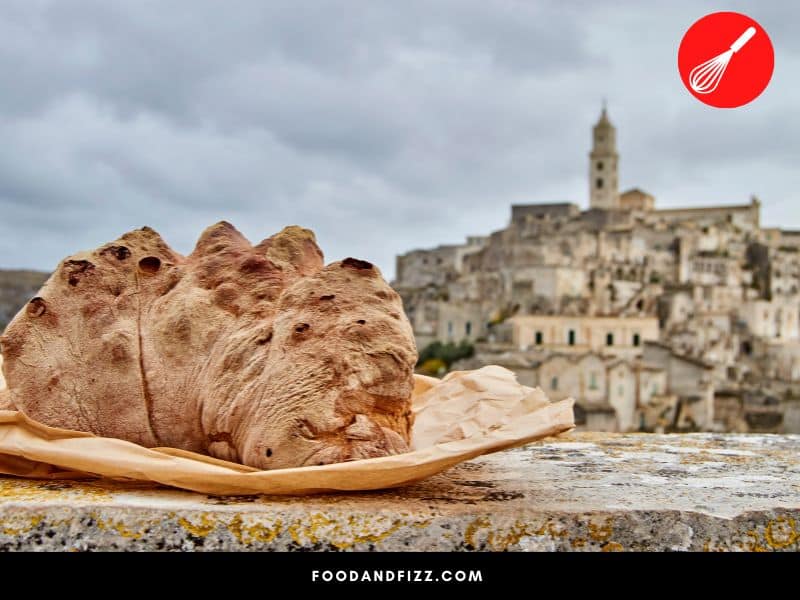
12. Caciocavallo
This easily recognizable, teardrop-shaped cheese is produced in many regions in southern Italy. It is oval in shape, with a smaller, round ball sitting on top of it. It is a cheese produced using the pasta filata method, like mozzarella but is further processed, cured, and air-dried, giving it a unique texture.
Young caciocavallo cheese is soft, bouncy, and stringy, but as it matures, it becomes harder in texture, especially its rind. It starts off as a milky white color but turns yellow as it ages.
It is traditionally made from cow or sheep’s milk, but buffalo milk versions exist. Its name literally means “horse cheese”, because when it is cured and dried, it looks like it is on horseback (“a cavallo”. Caciocavallo is said to have been mentioned as early as 500 B.C. by Hippocrates in his writings.
Caciocavallo Silano PDO is the most famous type, produced in the mountainous area of Sila in Calabria using locally sourced milk and strict guidelines, as required by its PDO status.
Caciocavallo Podolico is perhaps the most expensive variant as it can only be made from the milk of the rare Podolico cattle, who only produced limited amounts of milk per day.
The taste of caciocavallo depends on how long it is aged, and its price also shoots up the longer it is aged. Young caciocavello aged for about 60 days are springy, sweet and creamy.
Those aged 60-120 days have a harder texture, with more pronounced salty and spicy flavors. Those older than 120 days turn hard, crumbly, and have a sharper flavor.
- Characteristics: Oval shape, with a smaller round ball on top, flavor can be sweet and creamy or sharp and salty depending on how long it is aged
- Featured Ingredient: Cow’s milk or sheep’s milk
- Type of Dish: Cheese
- Region of Origin: Apulia, Basilicata, Molise, Calabria, Campania
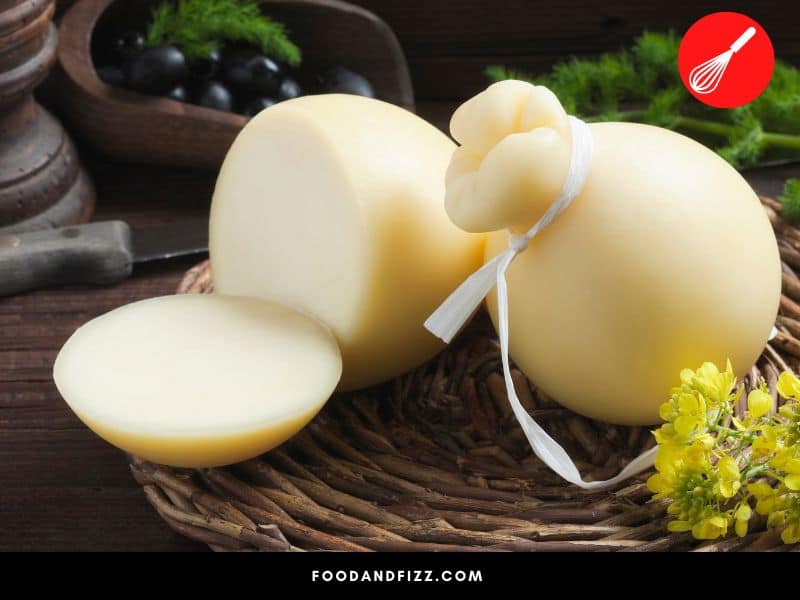
13. Burrata
Burrata is considered a typical food in the Puglia region, specifically the area of Murgia, and was said to have been developed in the 20th century, pretty young compared to other types of cheese.
It is a soft, fresh cow’s milk cheese made with mozzarella cheese and cream. It is a ball of mozzarella with soft curds and rich cream inside.
The Italian word “burro” which means butter, is where it gets its name, and it isn’t hard to see why.
On the outside, burrata looks like typical mozzarella, but once you slice into it and break it apart, the stracciatella oozes out and it becomes this rich, creamy, and buttery concoction that is just heavenly on its own, over a piece of bread, or in a salad.
Burrata should be eaten right away, as it will quickly deteriorate in quality. It has a pretty short shelf life and to get the best experience possible, have it when it’s freshly made.
- Characteristics: Soft, creamy and milk soft cheese with a sweet and buttery flavor
- Featured Ingredient: Cow’s milk
- Type of Dish: Cheese
- Region of Origin: Puglia
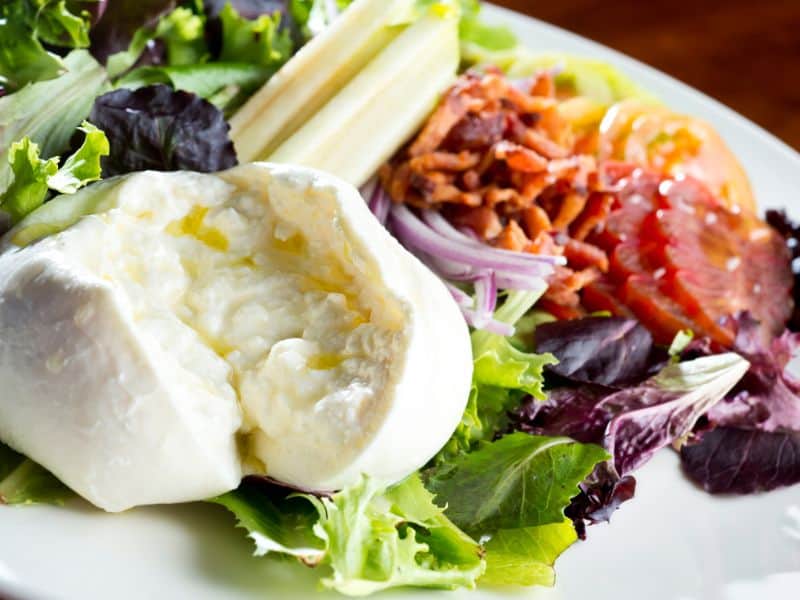
14. Canestrato Pugliese PDO
A round, hard cheese made from sheep’s milk that gets its name from the basket that it was formed in (canestro). It is yellow in color and is hard and grainy. It is a prized product from the Puglia region.
Young canestrato is delicate in flavor but more mature ones have a stronger, sharper, more piquant flavor.
- Characteristics: Round, cylindrical hard cheese, yellow in color, sharp in flavor
- Featured Ingredient: Sheep’s milk
- Type of Dish: Cheese
- Region of Origin: Puglia
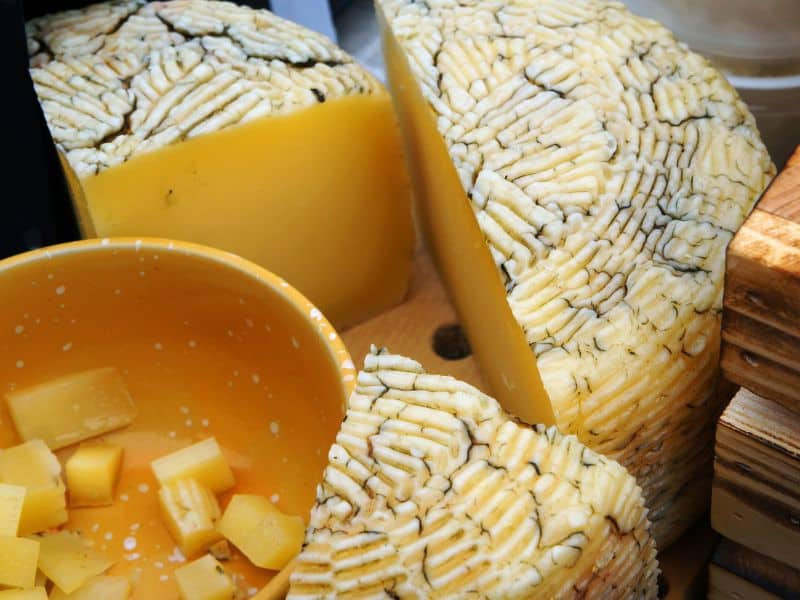
15. Soppressata di Calabria
Soppressata is a dry-cured pork salami popular in the South of Italy, with many amazing variations in the region. One of the most well-known is the one from Calabria, which is also the only one that has been granted a PDO status.
Soppressata looks quite different from other types of salami because of its cylindrical yet flattened shape, which is where it gets its name. “Pressare” means to press in Italian, and this is done to soppressata at the start of processing to squeeze out any air pockets.
While the soppressa of the North is pressed by hand, the soppressata of the south is pressed by using wooden planks and stones, with the meat wrapped in linen sheets. The pressing takes about a week, while the maturing takes about 45 days.
According to regulations, Soppressata di Calabria can only be produced in the region of Calabria, using locally raised pigs that are free-range. The addition of chili peppers, of which Calabria is a major producer, is what gives this cured salami a unique taste. Black pepper and cumin are also sometimes added.
Soppressata di Calabria is intense in flavor, slightly spicy and savory.
- Characteristics: Slightly spicy, savory, strong flavored dry-cured salami
- Featured Ingredient: Free-range pork raised in Calabria
- Type of Dish: Charcuterie
- Region of Origin: Calabria
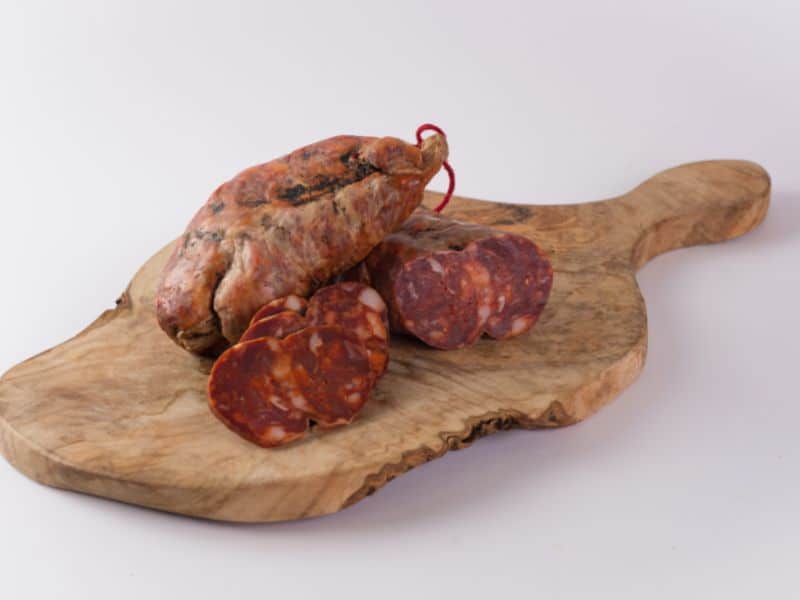
16. Su Porceddu (Sardinian Suckling Pig)
One of the island of Sardinia’s most popular meat dishes. A young pig, not over 40 days old is preferred for soft and tender meat.
The pig is cleaned and flavored with olive oil, fennel, salt, and pepper, and slow-cooked and roasted over a pit or over embers surrounding the pig for 4-5 hours.
Because it takes so long to prepare and even longer to cook, it is normally reserved for special occasions, like weddings and special gatherings.
- Characteristics: Roasted suckling pig, one of Sardinia’s most popular meat dishes
- Featured Ingredient: Young pig
- Type of Dish: Main dish, for special occasions
- Region of Origin: Sardinia

17. Lagane e Cicciari
Not to be confused with lasagna, lagane is a pasta typically seen in the Basilicata region of Italy and surrounding areas. It is a durum wheat pasta whose width is narrower than lasagna, but thicker and wider than tagliatelle.
It is used in soups and is commonly used tossed with vegetables and legumes, most especially chickpeas. Lagane e Cicciari is a pasta dish made with garlic, olive oil and chickpeas.
Lagane is said to be where lasagna came from, and is considered one of the oldest types of pasta, with the poet Horace making references to it in his writings. It is made fresh by hand in South Italy and there is very rarely a dried version of it.
- Characteristics: Long strips of pasta narrower than lasagna but thicker than tagliatelle
- Featured Ingredient: Durum wheat
- Type of Dish: Pasta
- Region of Origin: Basilicata
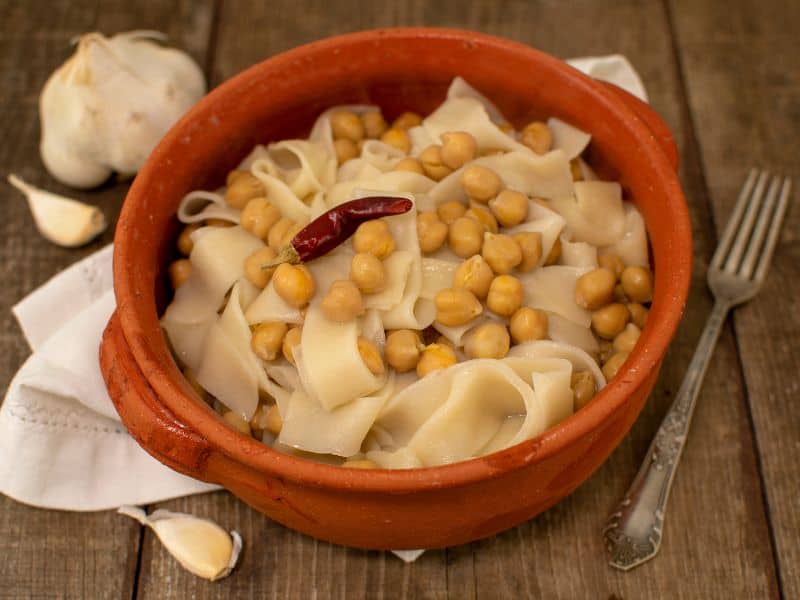
18. La Sardella
Also known as the caviar of the South, Rosamarina, caviar of the poor, or Calabrian caviar, sardella is a sauce made with small fish, hot Calabrian peppers and sometimes fennel. It is said to be the seafood version of the popular ‘Nduja.
It is a very traditional food that has origins that date back to the first century, to a fermented fish sauce called Garum, which the ancient Romans consumed. It is strong and spicy in flavor and it is usually spread over bread.
- Characteristics: Fermented fish condiment, spicy and strong in flavor
- Featured Ingredient: Calabrian chili peppers
- Type of Dish: Spread, snack
- Region of Origin: Calabria

19. Cipolla Rossa di Tropea IGP (Tropea Onions)
Onions are typically not on most people’s list of top foods to crave, but they said that one taste of Italian’s red queen – cipolla rossa di Tropea or simply Tropea onions–is sure to change your mind.
Known as the “red gold of Calabria”, Tropea onions grow along the cliffs and coast of Tropea and around the towns of Cape Vaticano, Briatico and Zambrone.
They are sweeter than a regular red onion, and are less pungent because they contain lower levels of pyruvic acid, which is what makes onions sharp and strong.
Because of its sweet and mild flavor, they can be used in pizzas, salad, pasta and many other dishes, and can even be consumed raw, on their own with just a tinge of oil. Locals like to say that a good Tropea onion can be eaten much like an apple.
Tropea onions enjoy IGP-status, so only tropeo onions grown in this geographical location is considered the real deal.
- Characteristics: Small, red onions that are sweet and less pungent than a regular onion
- Featured Ingredient: Red onion
- Type of Dish: Produce
- Region of Origin: Calabria
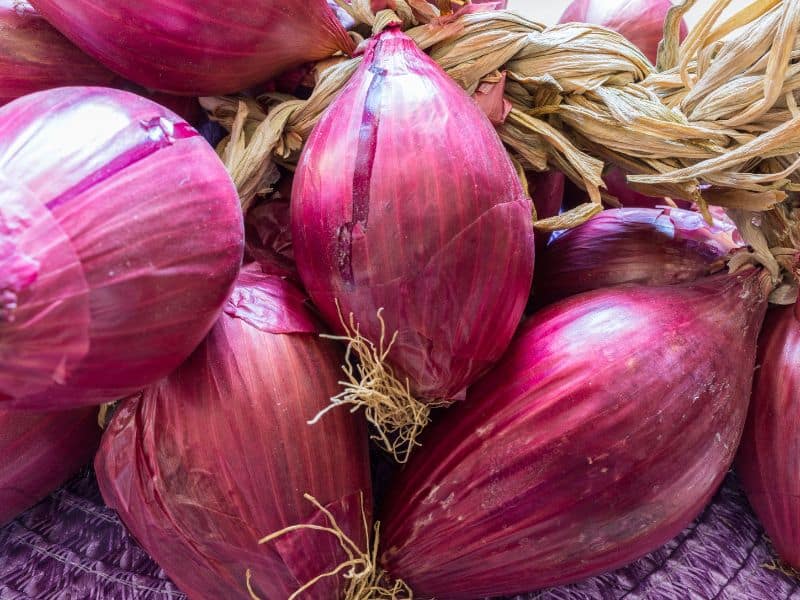
20. ‘Nduja
‘Nduja, (pronounced en-doo-ya) is a spreadable, fermented pork sausage that is a delicacy of the Calabrian region of southern Italy.
It has a meaty, somewhat funky, umami taste and is very spicy due to the abundance of Calabrian peppers, which is also what gives it its fiery vibrant red color. At its most basic, it is just ground pork, chilis, and salt, but other ingredients may be added depending on the producer.
Though its true origins are unknown, it is likely that this salami was created out of necessity by the farmers and poorer inhabitants of the region, who likely needed something that can make use of typically unusable parts of the animal such as the lungs and various other meat trimmings, so they can make food for themselves. Something delicious like a cured salami that will last them for a long time.
‘Nduja can be enjoyed on bread with cheese, added to various types of sauces, used as a topping for pizza or eggs and other dishes.
- Characteristics: Meaty, umami, spicy taste. Fermented, spreadable pork sausage
- Featured Ingredient: Pork, Calabrian chilis
- Type of Dish: Ingredient or condiment, snack
- Region of Origin: Calabria
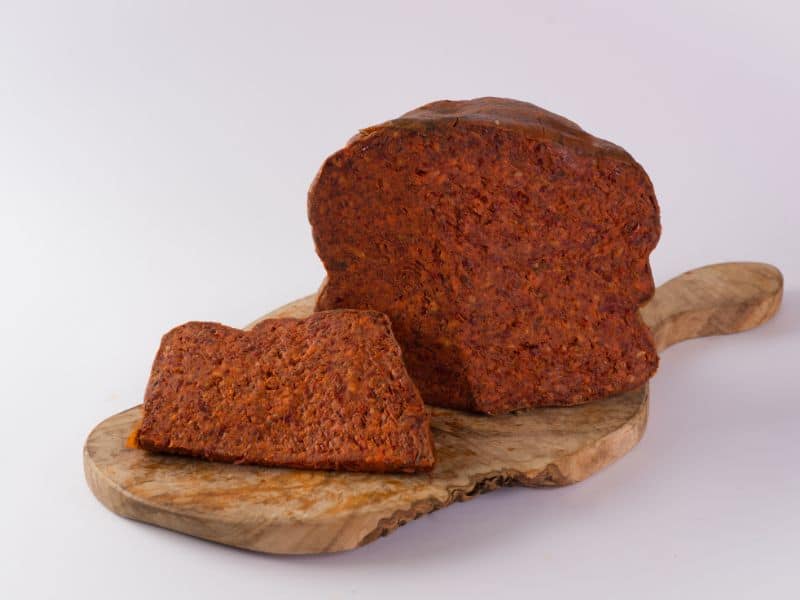
21. Arancini
A staple of Sicilian cuisine, arancini are stuffed rice balls that are coated in bread crumbs and then deep fried. The fillings vary and can range from slow-cooked meat, to vegetables, cheese and even things like ham or prosciutto.
The most common types are arancini al ragu (tomato-based meat sauce with rice and mozzarella), and arancini al burro (with butter or some type of white bechamel sauce).
Its name comes from the Italian word for orange, “arancia”, which the rice balls are said resemble after they are deep fried, with their orange hue.
The term arancini is the masculine and plural form of arancino, which are the terms of preference in the eastern side of Sicily, in Catania. On the western side of the island, in Palermo, the feminine forms are much preferred: arancine (plural) and arancina.
These two terms also resulted in two different variations of the same dish. The rice balls in Palermo and western Sicily have retained their round shape while the ones on the east side, in Catania, have evolved into a conical shape that is said to represent Mount Etna.
- Characteristics: Stuffed rice balls round or conical in shape, breaded and deep fried
- Featured Ingredient: Rice, meat, cheese
- Type of Dish: Snack
- Region of Origin: Sicily
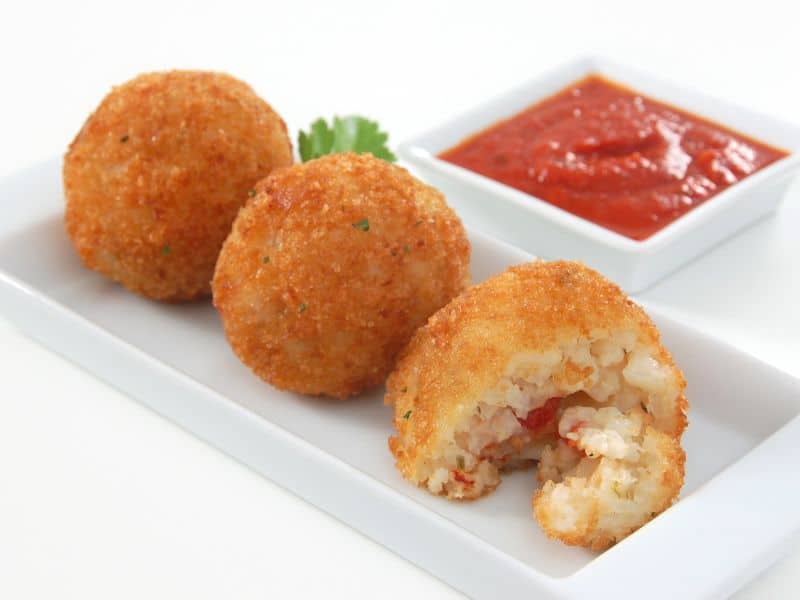
22. Caponata
Caponata is arguably the most famous Sicilian dish. It is a dish of stewed vegetables in a sweet and sour sauce. It is usually comprised of chopped aubergines or eggplants, onions, vinegar, olives, capers, celery, and tomatoes.
It is typically served as a side to a seafood dish, but can also be a main dish in itself. It is like ratatouille, except the sauce is sweet and sour.
Caponata is a dish that shows Sicily’s Arab, Greek and Spanish influences, through the use of specific ingredients as well as the resulting flavors and textures present in the dish.
It is said that there are many ways to make caponata in Sicily, with each place and household adding their own embellishments to the dish, ranging from breadcrumbs, to grated chocolate.
While this fact may make it quite challenging for someone attempting to capture the authentic taste of Sicilian cuisine, it can also offer some sort of relief in that there really is no one way to make caponata, and you can easily make it your own.
- Characteristics: Stewed vegetables with eggplant as the centerpiece, sweet and sour flavor
- Featured Ingredient: Aubergine or eggplant
- Type of Dish: Side or main dish
- Region of Origin: Sicily
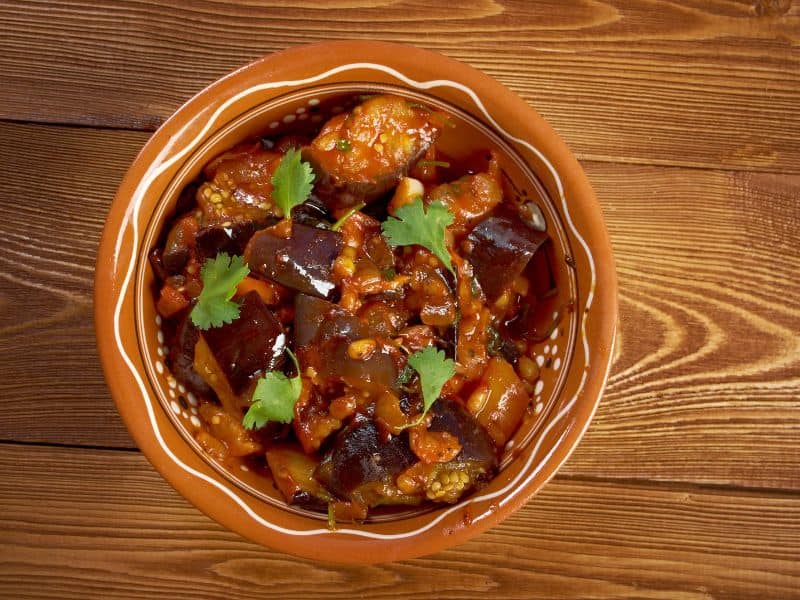
23. Pasta Alla Norma
Pasta Alla Norma is another dish of Sicilian origin that makes use of eggplants as the main ingredient. It is a tomato-based pasta dish that originated in the city of Catania, and is made by tossing fried eggplant in a marinara sauce with fresh basil and a sprinkling of ricotta salata cheese.
It is named after the opera Norma, in honor of its composer, Vincenzo Bellini, who was a native of Catania.
Pasta Alla Norma is simple, easy to make and is a vegetarian-friendly dish that reflects classic Sicilian flavors.
- Characteristics: Pasta tossed in marinara sauce with eggplants, basil and ricotta salata cheese.
- Featured Ingredient: Eggplants
- Type of Dish: Pasta
- Region of Origin: Sicily
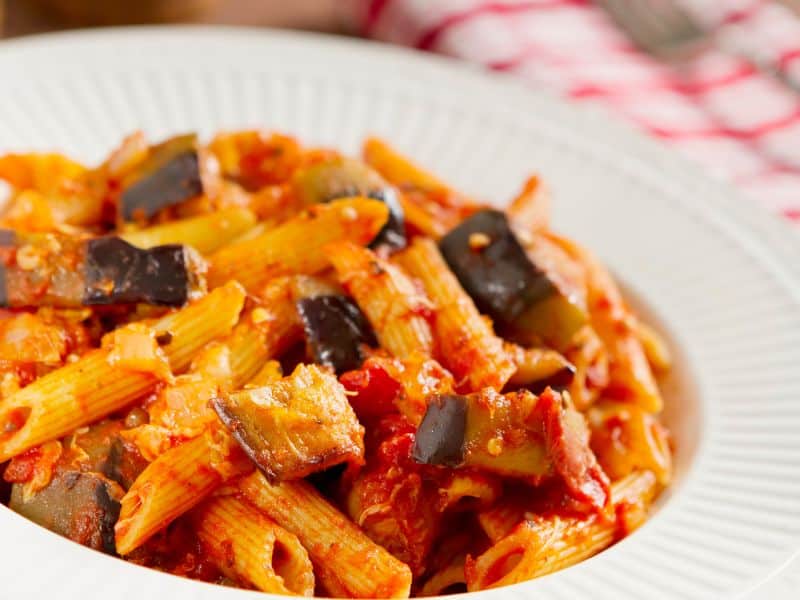
24. Cannoli
Cannoli are tube-shaped, fried Sicilian pastries that are filled with sweet and creamy ricotta cheese filling. The pastry shell is made with flour, sugar, butter and eggs.
Marsala wine is added to the dough for sweetness and flavor, as well as to make the dough light and flaky.
The filling traditionally used is sweetened sheep’s milk ricotta cheese but nowadays, cow’s milk ricotta is used as well as other things like mascarpone.
Additional fillings and flavorings may be added, such as cinnamon, cocoa powder, chocolate, pistachio nuts, candied orange peel, and others. It is typically served with dusted powdered sugar on top.
- Characteristics: Tubular, fried pastry filled with sweetened ricotta cheese, topped with powdered sugar
- Featured Ingredient: Crispy tubular pastry shells, sweetened ricotta
- Type of Dish: Dessert
- Region of Origin: Sicily

25. Cassata Siciliana
Cassata Siciliana is a traditional, elegant cake from Italy that is usually served during Easter, as a signal of the end of the Lenten fast. It is an opulent, Baroque-style cake that consists of juice or liquer-infused sponge cake layered with sweetened ricotta cheese, covered in green-tinted marzipan, and decorated with white glaze and candied fruits.
It was the nuns that started the tradition of making it as an Easter treat and it is said that cassata was so delicious that it had to be banned during Holy Week by the local diocese in 1574 because the nuns loved baking and eating it too much that they forgot their prayers! Imagine how delicious this cake must be.
- Characteristics: Baroque-style cake, infused sponge cake, sweet ricotta, marzipan covering and candied fruit topping
- Featured Ingredient: Ricotta cheese, marzipan
- Type of Dish: Dessert
- Region of Origin: Sicily

26. Limoncello
Limoncello is a lemon liqueur made by infusing lemon zest in alcohol and is a drink that has come to represent the Amalfi Coast. It is usually a digestive, or after-dinner drink, but it can also be used to infuse flavor into desserts.
Limoncello must be made with untreated lemons, traditionally with Sorrento lemons. The peel, without the bitter white part, must be thoroughly cleaned before it can be infused in the alcohol, for a minimum of 6 days.
After this period, the alcohol-lemon mixture is filtered and a simple syrup is added. It is then poured into a glass bottle, where it will be sealed and left to ferment for at least a month.
The resulting liqueur is sweet and has a concentrated citrus flavor. It is usually served ice-cold.
- Characteristics: Sweet, lemon liqueur served ice-cold
- Featured Ingredient: Lemons
- Type of Dish: Digestivo, or used in desserts
- Region of Origin: Sorrento, Amalfi Coast, Campania

Conclusion to 26 Most Popular Southern Italian Foods
The south of Italy gave birth to some of the most iconic and notable Italian exports to the world, such as pizza, pasta, mozzarella, sfogliatelle, cannoli, limoncello, as well as popular dishes like Caponata and Spaghetti Alla Puttanesca.
It also has treasured breadmaking and cheesemaking industries that gave birth to the Foccacia Barese, Pane di Altamura and Matera, Mozzarella Bufala di Campania, Caciocavallo and Burrata.
With its diverse regional cuisine, Italy remains to be one of the best places to explore if you love to eat, and love to immerse yourself in a cuisine with a rich and diverse history.

